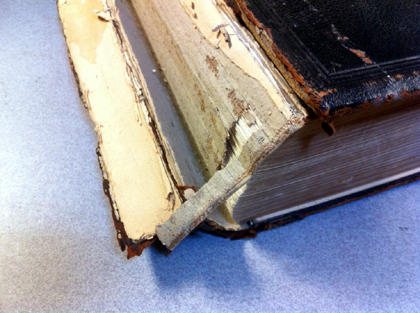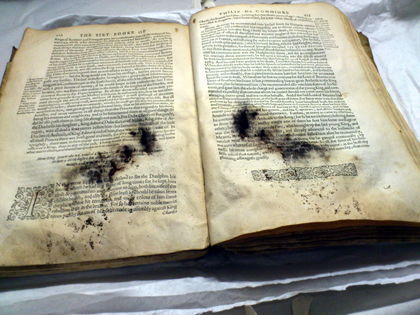What Ails our Books?
For your viewing pleasure, a rogues' gallery of the most common book injuries encountered at The New York Society Library.
Split text block
Older bindings are subject to splitting due to animal glue hardening and sewing failure. Newer “perfect” bindings (spine edge guillotined off and glued up), common with today’s mass market best sellers, are not sewn and so only depend on a layer of glue to hold the pages in place.

Failure of sewing
Incorrect choice of thread thickness, sewing that is too tight, overuse, or age of the thread contributes to this type of structure failure
Partially /fully detached spine
Constant opening and closing of the front and rear boards weakens the covering material at the outside joints of a book. When this happens, it is not uncommon for the spine to pop off.
Detached boards
The most heavily stressed part of the book is where the front and back covers are opened and closed. It is not surprising, therefore, that bindings tend to fail at their outside joints resulting in detached boards.
Blunted /damaged corners
Corner blunting is common. Over years of constant use (or misuse, as the case may be) covering material may fray or pull back from a binding at its corners, exposing the underlying board. If the damage becomes too extreme, the textblock will no longer be protected by its cover.
Damage to spine at head
Pulling a book from a shelf in an improper manner (i.e., by pulling on the headcap with a finger), leads to this common injury. This type of damage can often lead to spine detachment or headband damage.
Damage to headband
Books bound before the advent of machine binding typically have hand-sewn headbands. These often attractive and functional accents can be damaged as a result of improper handling and shelving (see above).

Degrading of leather “Red Rot”
This breakdown of leather is a result of the chemical interaction of products used during the tanning process and various atmospheric pollutants. Over time, degradation results in the formation of a powdery residue commonly referred to as “red rot.”
Paper tears
Tears range from small, simple and straight to large, irregularly shaped missing chunks.

Detached pages or sections
Individual pages and or entire sections may fall out due to failed adhesive or broken sewing.
Cellophane/water-based tapes
From books repaired with simple, “scotch tape” to the formerly accepted library practice of lining book spines with green, water-activated adhesive tape (look for them in the stacks!), tape can be found everywhere in the library. Depending on the type of tape used removing it from books or pages can be a very time-consuming project with mixed results.
Mold and Mildew
An insidious problem. When a book becomes infected with mold, it should be quarantined from the rest of the collection as soon as possible. High humidity and temperature can cause dormant mold spores to bloom . . . more on this topic in a later post.


Disqus Comments